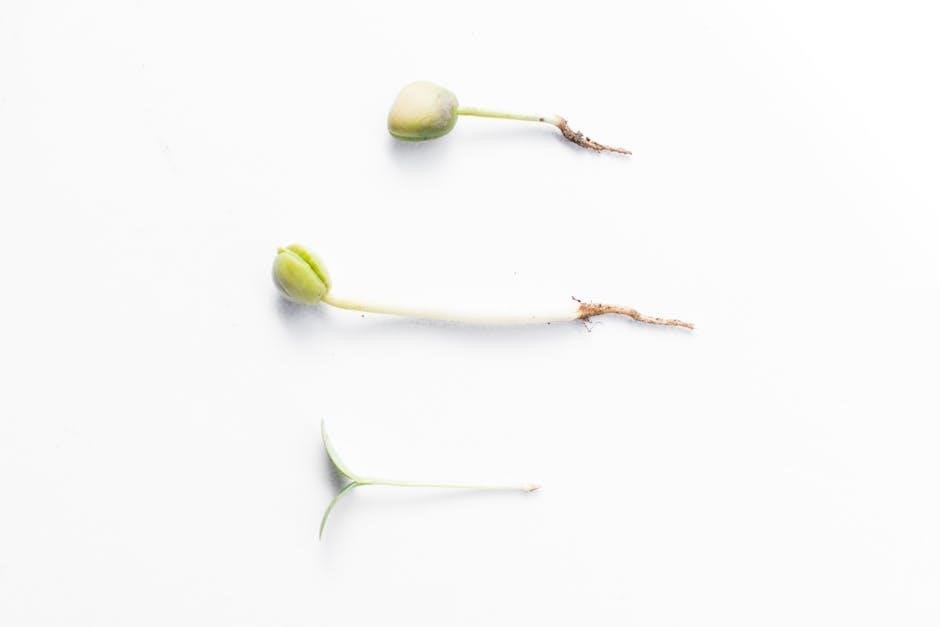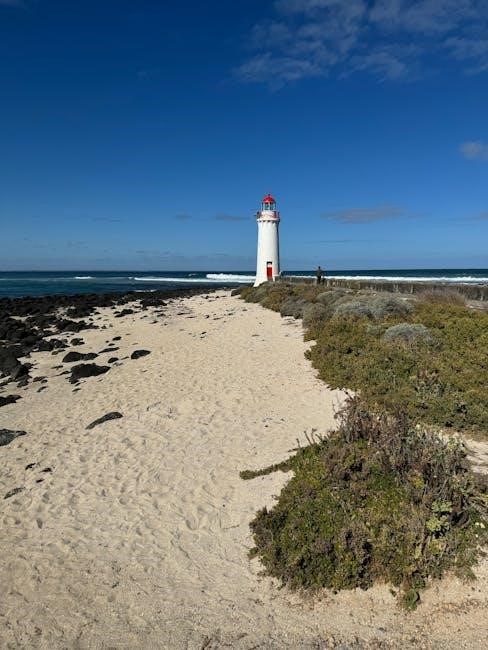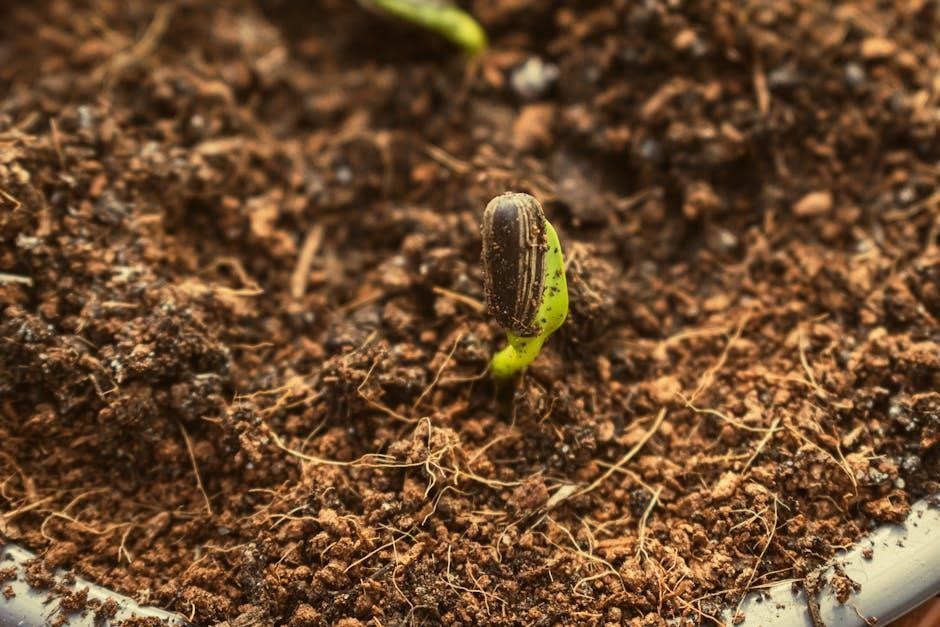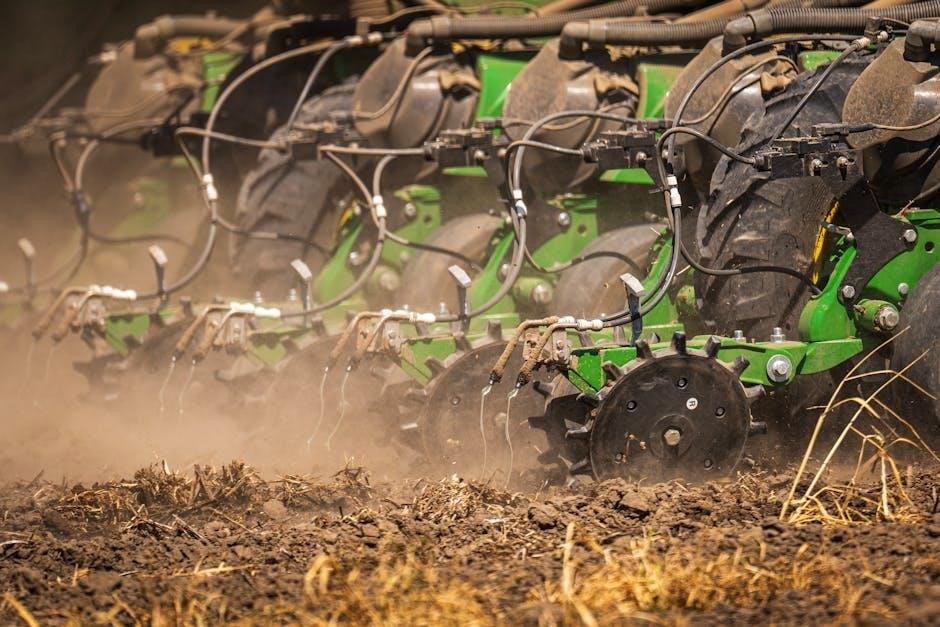west coast seed planting guide
Welcome to the West Coast Seed Planting Guide, your ultimate resource for gardening success in diverse climates. Discover optimal planting times, frost dates, and sustainable practices to maximize your harvest.
Explore tailored advice for spring and fall planting, companion planting strategies, and tips for small spaces. This guide helps you grow naturally, ensuring a bountiful and thriving garden.
Welcome to the West Coast Seed Planting Guide, your comprehensive resource for gardening success in the diverse climates of the West Coast. Whether you’re a seasoned gardener or just starting out, this guide provides essential insights to help you optimize your planting schedules, understand regional frost dates, and make the most of your growing season. From spring to fall, we cover tailored advice for planting seeds, sustainable practices, and companion planting strategies to ensure a bountiful harvest. Explore detailed charts, zone-specific tips, and expert recommendations to grow strong, healthy plants. This guide is your roadmap to thriving gardens, no matter your skill level or location;
Understanding West Coast Climates
The West Coast features diverse climates, from mild to extreme, across regions like Northern California, the Pacific Northwest, and the Desert Southwest. Understanding these variations is key to successful planting decisions and ensuring optimal growth for your seeds.
Northern California Climate Overview
Northern California’s climate is characterized by cool, wet winters and warm, dry summers, influenced by its Mediterranean-like conditions. The region spans USDA hardiness zones 8-10, with varying microclimates due to coastal and inland differences. Coastal areas experience mild temperatures with frequent fog, while inland regions endure hotter summers and colder winters. Understanding these patterns is crucial for planting, as frost dates and moisture levels significantly impact crop selection and timing. Gardeners in Northern California benefit from a long growing season, but must adapt to periodic droughts and temperature fluctuations. This climate diversity makes it essential to choose seeds suited to specific local conditions, ensuring optimal growth and harvest success.
Central Coast Climate Conditions
The Central Coast of California enjoys a unique climate with cool, foggy mornings and warm afternoons, falling within USDA zones 8-10. This region benefits from a moderate temperature range, with minimal extreme weather events. Coastal areas receive consistent moisture, while inland regions experience drier conditions. The growing season is extended, allowing for multiple crops annually. However, the cool, moist winters and hot, dry summers require careful planning for seed selection and planting schedules. Understanding these conditions helps gardeners optimize their planting strategies, ensuring healthy plant growth and abundant harvests throughout the year.
Southern California Climate Characteristics
Southern California is characterized by a Mediterranean climate, with hot, dry summers and mild, wet winters. This region falls within USDA zones 9-11, offering a long growing season. The warm temperatures and low humidity create ideal conditions for a variety of crops, but drought tolerance is crucial. Coastal areas benefit from cooler ocean breezes, while inland regions experience extreme heat. Gardens here thrive with plants adapted to these conditions, requiring careful water management. Understanding these climate patterns is essential for successful planting and maintaining a vibrant, productive garden year-round in Southern California.
Pacific Northwest Climate Patterns
The Pacific Northwest (PNW) features a mild oceanic climate with cool, wet winters and mild, dry summers. This region spans USDA zones 6-8, with consistent rainfall and overcast skies during winter months. The moderate temperatures and ample moisture create a fertile ground for a wide range of crops, particularly greens, Brassicas, and root vegetables. However, the shorter growing season and limited sunlight during winter require careful planning. Gardeners in the PNW benefit from selecting varieties with shorter maturation periods and employing techniques like cold frames or greenhouses to extend the growing season. Adaptation to these patterns is key for a thriving PNW garden.
Desert Southwest Climate Features
The Desert Southwest is characterized by hot, arid conditions with very low humidity and intense sunlight. Summers are extremely hot, while winters are mild, creating a unique challenge for gardeners. This region falls under USDA zones 9-11, with a growing season split into two main periods: spring and fall. Planting heat-tolerant crops like tomatoes, peppers, and okra is ideal during the spring, while cooler crops such as spinach and carrots thrive in the fall. Water conservation is critical, making techniques like drip irrigation essential. Understanding these climate features helps gardeners select appropriate varieties and manage resources effectively for a successful harvest in the Desert Southwest.

Finding Your Planting Zone
Identify your USDA Hardiness Zone to determine the best planting times for your region. Use online tools to pinpoint your zone and ensure optimal growing conditions.
How to Determine Your Planting Zone
To determine your planting zone, use the USDA Plant Hardiness Zone Map or online tools like the Plant Hardiness Zone Finder. Enter your address or zip code to find your specific zone. This zone indicates the average annual extreme minimum temperature in your area, which is crucial for selecting plants that can thrive. Check planting charts specific to your zone for optimal sowing times. Knowing your zone helps you avoid planting too early or late, ensuring crops mature before frost. For regions like the West Coast, zones vary significantly, so accurate determination is key for successful gardening. Elevations and microclimates can also affect local conditions.
Why Knowing Your Zone Matters
Knowing your planting zone is essential for selecting plants that thrive in your local climate. It determines the best times to plant and harvest, ensuring crops mature before frost; Zone-specific planting charts help avoid common mistakes, like sowing too early or late. This knowledge also aids in choosing seeds suited to your area’s temperature and season length. For the West Coast, where zones vary widely, understanding your zone ensures optimal growth and reduces risks. It’s a crucial step for a successful, bountiful garden, helping you make informed decisions tailored to your region’s unique conditions.

Planting Charts and Calendars
Planting charts and calendars provide essential timing for sowing seeds, ensuring crops mature before frost. Tailored for West Coast zones, they help gardeners optimize growing seasons and avoid pests.
Spring Planting Dates
Spring planting dates vary across the West Coast, depending on your specific zone; Generally, start seeds indoors 8-10 weeks before the last frost date. Direct sow in early spring when soil warms. Use our Planting Zone Finder Tool to determine exact timing for your area. Zones 5-10 have distinct planting windows to avoid frost and pests. Check seed packets for days to harvest and plan accordingly. Early spring crops like spinach and peas thrive in cooler conditions. Warmer crops like tomatoes and peppers should be planted after the last frost. Refer to our 2025 Gardening Guide for detailed charts and regional advice to maximize your spring garden’s growth and success.
Fall Planting Dates
Fall planting dates on the West Coast require careful planning to avoid the first frost. Start seeds indoors 6-8 weeks before transplanting outside. Direct sow cool-season crops like kale, spinach, and carrots when soil cools. Zones 5-10 have varying frost dates, so check your zone for specific timing. Plant root vegetables and Brassicas 8-12 weeks before the first frost. Leafy greens can be direct sown 4-6 weeks before frost. Use our Planting Zone Finder Tool for exact dates. Ensure crops mature before winter by counting days to harvest from seed packets. Fall gardens thrive in cooler temperatures, making it ideal for second harvests and preparing for winter storage.

Optimizing Planting Schedules
Optimize your planting schedule by understanding frost dates, using planting charts, and considering days to harvest. This ensures crops mature before winter, maximizing your garden’s productivity and success.
Starting Seeds Indoors
Starting seeds indoors is a great way to get a head start on the growing season, especially for crops that require a longer growing period. Use peat or coir pots to prevent root disturbance when transplanting. Sow seeds 8-10 weeks before the last frost date, placing them on the surface of pre-moistened soil. Cover with a plastic bag to maintain humidity and promote germination. Ensure adequate light and maintain consistent temperatures for optimal growth. This method works well for both spring and fall plantings, allowing you to transplant healthy seedlings outdoors when conditions are favorable.
Direct Sowing Seeds
Direct sowing seeds is a straightforward method that eliminates the need for indoor starting. Choose early spring or early autumn for optimal results, as these seasons offer cooler temperatures and consistent moisture. Prepare the soil by loosening it to the seed’s required depth, ensuring good drainage and fertility. Sow seeds on the surface or at the recommended depth, depending on the variety, and water gently. Avoid overwatering, which can lead to poor germination or seed rot. Use a garden fork or tiller to prepare larger areas and a small tool like a dibber for precise sowing. This method reduces transplant shock, allowing seedlings to establish strong root systems directly in their growing environment.
Considering Days to Harvest
Understanding the days to harvest is crucial for planning your garden effectively. This duration, typically found on seed packets, helps you schedule plantings to ensure crops mature before frost or extreme weather; For instance, faster-growing crops like lettuce (20-40 days) can be successionally planted, while tomatoes (60-90 days) require earlier sowing. Plan backward from your first frost date to avoid unfinished harvests. Use a gardening journal to track progress and adjust planting schedules yearly. This approach ensures a continuous yield and maximizes your growing season, especially in regions with shorter summers. Proper timing also prevents crops from bolting or becoming less flavorful.
Understanding Frost Dates
Frost dates are critical for West Coast gardeners, as they determine the optimal planting times to avoid crop damage. The first frost date marks the end of the growing season, while the last frost date signals when it’s safe to plant warm-season crops. These dates vary significantly across regions, from coastal areas to inland zones. Planting too early risks frost damage, while delaying too long shortens the growing season. Use frost date calculators or local gardening resources to pinpoint these dates for your specific area. Knowing your frost dates ensures timely planting, protects your crops, and maximizes your harvest potential throughout the year.

Companion Planting Guide
Companion planting enhances growth and deters pests naturally. Discover how pairing plants like marigolds with tomatoes or basil with peppers boosts health and flavor. Explore expert tips here.
Basics of Companion Planting
Companion planting is a natural gardening method that uses plant diversity to enhance growth, deter pests, and improve overall garden health. By strategically placing complementary plants together, gardeners can create balanced ecosystems. Some plants repel pests, while others attract beneficial insects or improve soil health. For instance, marigolds repel nematodes, while basil attracts pollinators. Understanding which plants thrive together is key to a successful and sustainable garden. This technique reduces the need for pesticides and fosters a more resilient growing environment. Start by planning your plant pairings based on their growth habits and benefits to maximize your garden’s potential.
Popular Companion Planting Combinations
Discover effective plant pairings to enhance your garden’s health and productivity. Marigolds repel nematodes and attract beneficial insects, making them ideal for tomato beds. Basil improves tomato flavor while deterring pests like aphids and mites. Nasturtiums repel aphids, whiteflies, and other pests, benefiting cucumbers and squash. Radishes can deter cucumber beetles, protecting your harvest. Borage attracts pollinators and enhances strawberry yields. Planting garlic near roses deters aphids and improves rose health. These combinations create a balanced ecosystem, reducing pests and fostering growth. Experiment with these pairings to optimize your garden’s potential and enjoy a more sustainable harvest. Companion planting is a simple yet powerful tool for natural gardening success.

Gardening Tools and Resources
Essential tools include our 2025 Gardening Guide, Planting Zone Finder, and Gardening Journal. These resources help you plan, track progress, and achieve a successful harvest season.
2025 Gardening Guide
The 2025 Gardening Guide is your essential resource for a successful growing season. Packed with over 100 new plant varieties, it offers detailed crop planning tools, sustainable gardening tips, and expert advice. While direct mailing has concluded, the digital version remains accessible, ensuring you can plan and execute your garden effortlessly. This guide is tailored to help gardeners make informed decisions, from planting charts to harvest strategies. With a focus on sustainability, it also highlights West Coast Seeds’ partnership with Food Banks Canada to address food insecurity. Use this comprehensive guide to optimize your garden’s potential and enjoy a bountiful harvest.
Planting Zone Finder Tool
Our Planting Zone Finder Tool simplifies determining your specific growing zone, crucial for selecting the right plants and timing. By entering your address, you receive a detailed zone profile, helping you make informed planting decisions. This tool ensures you plant crops at the optimal time, maximizing growth and yield. It’s a valuable resource for both seasoned gardeners and newcomers, providing insights into local climate conditions and frost dates. Use this tool to align your gardening efforts with your region’s unique characteristics, ensuring a successful and thriving garden throughout the year.
Gardening Journal
A gardening journal is an essential tool for tracking your progress and planning future harvests. West Coast Seeds offers a printable journal designed to guide you from seed selection to harvest. It includes space for noting weather patterns, soil conditions, and planting schedules. Documenting your gardening journey helps you identify successes and challenges, allowing you to refine your techniques over time. The journal also serves as a personalized guide, offering tips for organic gardening methods and sustainable practices. By keeping a record of your efforts, you can better understand your garden’s needs and make informed decisions for future growing seasons.

Urban Gardening Tips
Maximize small spaces with container gardens and vertical growing solutions. Perfect for city gardens, these methods optimize space while yielding abundant harvests in urban settings.
Growing in Small Spaces
Growing in small spaces is achievable with the right strategies. Use vertical gardening techniques like trellises or wall-mounted planters to save space. Consider compact or dwarf varieties of plants, which are specifically bred for smaller areas and produce high yields. Utilize containers with good drainage to ensure healthy root growth. Incorporate companion planting to maximize space and deter pests naturally. Additionally, make the most of balconies, patios, or even windowsills by selecting plants that thrive in partial shade or full sun, depending on your location. Regularly monitor soil health and water conservation to maintain productivity in your limited space garden.
Container Gardening
Container gardening offers flexibility and versatility for West Coast gardeners. Choose containers with drainage holes to prevent waterlogged soil and root rot. Select a high-quality potting mix designed for containers, as it retains moisture yet drains excess water. Place containers in locations that receive the recommended sunlight for your plants. Use self-watering containers or add a layer of mulch to conserve water. Incorporate a balanced fertilizer to promote healthy growth. Consider growing herbs, vegetables, or flowers in containers, as many varieties thrive in this setting. Regularly inspect plants for pests and diseases, and rotate crops seasonally to maintain soil health and diversity in your container garden.

Seed Starting Tips
Start seeds indoors in peat or coir pots 8-10 weeks before planting out. For direct sowing, place seeds on pre-moistened soil, cover with a plastic bag. Harden off seedlings before outdoor transplanting for optimal success.
When to Start Seeds Indoors
Start seeds indoors 8-10 weeks before the last frost date in your area. This allows seedlings to mature before being transplanted outdoors. For the West Coast, where frosts are rare, you can begin as early as late winter. Use peat or coir pots to prevent root disturbance. Place seeds on the surface of pre-moistened soil, then cover with a plastic bag to maintain humidity. Ensure adequate light and warmth for germination. Once seedlings emerge, provide strong light sources, such as grow lights, to promote healthy growth. Harden off seedlings before moving them outdoors to avoid shock. This method ensures robust starts and a head start on the growing season. Perfect for year-round gardening in mild West Coast climates.
How to Sow Seeds Indoors
Start by filling peat or coir pots with pre-moistened soil. Place seeds on the surface, following package instructions for depth. Cover with a plastic bag to retain humidity. Position pots in a warm, bright location, avoiding direct sunlight. Maintain consistent temperatures between 65-75°F for optimal germination. Once seeds emerge, remove the bag and provide indirect light. Use grow lights if natural light is insufficient. Label pots with seed variety and date. Keep soil moist but not waterlogged. Transplant seedlings outdoors after hardening off. This method ensures healthy starts and strong root development for West Coast gardeners, promoting successful growth in the region’s mild climate.
Hardening Off Seedlings
Hardening off seedlings is a critical step before transplanting them outdoors. Start by moving seedlings to a shaded outdoor area for 1-2 hours daily, gradually increasing exposure to sunlight and wind over 7-10 days. Avoid direct sun during peak hours to prevent scorching. Ensure plants are protected from strong winds, which can cause damage. Monitor seedlings for signs of stress, such as wilting or discoloration, and adjust exposure accordingly. This process thickens the cuticle on leaves, reducing water loss and preparing seedlings for outdoor conditions. Proper hardening off ensures a smoother transition, boosting their chances of thriving in West Coast gardens.

Sustainable Gardening Practices
Sustainable gardening practices involve using non-GMO seeds, organic methods, and water conservation techniques to reduce environmental impact and support healthy plant growth and biodiversity.
Organic Gardening Methods
Organic gardening emphasizes natural processes, avoiding synthetic chemicals. Use non-GMO seeds, compost, and natural fertilizers to enrich soil health. Implement crop rotation and companion planting to deter pests and enhance growth. West Coast Seeds offers untreated, non-GMO varieties ideal for organic practices, ensuring healthy, chemical-free harvests. By adopting these methods, gardeners promote biodiversity, reduce environmental impact, and grow nutritious, flavorful crops. These practices align with sustainable farming principles, fostering a balanced ecosystem. Explore detailed guides and resources from West Coast Seeds to transition to organic gardening, supporting both your garden and the planet’s well-being. Their partnership with Food Banks Canada further highlights their commitment to community and sustainability.
Using Non-GMO Seeds
Choosing non-GMO seeds ensures your garden stays free from genetically modified organisms, preserving natural plant diversity. These seeds are ideal for organic gardening, promoting healthier crops and ecosystems. West Coast Seeds offers a wide selection of untreated, non-GMO varieties, perfect for sustainable farming and home gardens. By selecting non-GMO seeds, you support biodiversity and avoid exposure to synthetic pesticides and herbicides. This approach aligns with eco-friendly practices, ensuring your harvest remains chemical-free and nutritious. West Coast Seeds has been trusted since 1983 for providing high-quality, reliable seeds tailored to regional climates, helping gardeners achieve successful and sustainable growth.
Water Conservation Techniques
Conserving water is crucial for sustainable gardening on the West Coast. Use drought-resistant plants and mulch to retain soil moisture, reducing evaporation. Install drip irrigation systems for efficient watering. Collect rainwater in barrels to supplement your water supply. Avoid overwatering by checking soil moisture before watering. Time irrigation during early morning or evening to minimize evaporation. Use cover crops to protect soil and reduce water loss. Implementing these techniques ensures healthy plant growth while preserving this vital resource.

West Coast Seeds Company Overview
West Coast Seeds is a family-owned business based in Delta, BC, offering high-quality, non-GMO seeds since 1983. They specialize in sustainable gardening solutions and community support.
History and Mission
West Coast Seeds, established in 1983, is a family-owned business rooted in Delta, BC. With a passion for sustainable gardening, they specialize in non-GMO, untreated seeds suitable for organic growing. Their mission is to empower gardeners with high-quality products and educational resources, fostering a connection between people and the earth. Dedicated to environmental stewardship, West Coast Seeds collaborates with organizations like Food Banks Canada to address food insecurity. For over four decades, they have remained committed to helping gardeners succeed, offering diverse seed varieties and expert advice to support thriving, eco-friendly gardens across the West Coast and beyond.
2023 New Varieties
West Coast Seeds introduced over 100 exciting new plant varieties in their 2023 catalog, blending innovation with tradition. These additions include unique vegetable, herb, and flower species, each chosen for their adaptability to West Coast climates. Highlights feature disease-resistant tomatoes, vibrant pollinator-friendly flowers, and heirloom selections that enhance biodiversity. Many varieties are bred for shorter growing seasons, ideal for cooler regions. This expansion supports gardeners in creating resilient, productive, and visually stunning gardens. With a focus on sustainability, these new offerings continue West Coast Seeds’ legacy of providing high-quality, non-GMO options for every type of gardener, from urban growers to rural farmers.
Embark on a successful West Coast gardening journey with our comprehensive guide. Tailored for diverse climates, it offers insights into planting zones, frost dates, and sustainable practices. Explore optimal planting charts and companion planting strategies to enhance your harvest. Whether you’re growing in small spaces or vast areas, our guide provides essential tools and resources. Utilize the 2025 Gardening Guide and Planting Zone Finder to make informed decisions. With a focus on organic and non-GMO seeds, West Coast Seeds empowers gardeners to cultivate thriving, eco-friendly gardens. Start your seeds with confidence, knowing you have the expertise to nurture them from sowing to harvest.
